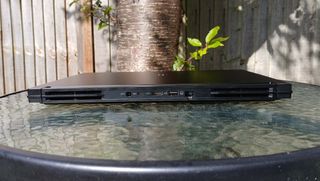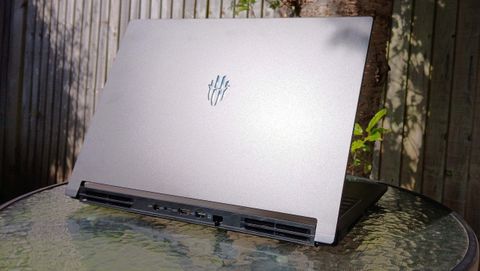Our Verdict
The Titan 16 Pro shatters rendering benchmarks, but stutters without the help of DLSS in gaming benchies. With a high refresh panel it still has the option for competitive gaming, but you'll have to switch the settings down to make the most of it. And while it's got a gorgeous chassis and isn't too overpriced, Intel's high-end 14th Gen processor is undermined a little here by the RTX 4060 GPU pairing.
For
- Lovely click on the glass touchpad
- Beautiful manufacturing
- Sturdy chassis
- Great rendering performance
- High refresh rate panel
Against
- Stutters in CPU-heavy games
- OTT keyboard with inconsistent typeface
- Front edge is a bit sharp
- Noisy fans even when idle
- CPU still gets real hot
- Sub-par battery life
- Single-channel memory
PC Gamer's got your back
Titan 16 Pro really stands out from the rest of the RedMagic gaming laptop lineup because, uh… there isn't one. RedMagic has never made a laptop before. It's made gaming phones, gaming accessories, monitors, and mouse pads, but the Titan 16 Pro is the company's first foray into actual laptop territory. On paper it looks pretty good, with a high-wattage GPU, high-refresh panel, and DDR5-5600 RAM, but can it match the competition?
Out of the box, it's clear all that gaming smartphone design has influenced the Titan 16 Pro. We're talking sheer, beautifully milled, matte black metal with hardly any greebles, just the RedMagic logo illuminated with RGB lighting on the back. It's made from a single piece of machined metal, and although the power cable blocks the screen from going back too far and the front edge is a bit sharp, the chassis is nicely understated. Personally, I think it's external looks rival the Razer Blade machines our Dave is so in love with, but that's an argument for behind the scenes.
One of the specs listed on the RedMagic Titan 16 Pro site is "All black internal components", as if that's something people are looking for in a laptop. Will it help you game better? Probably not, but it's totally brutal (throws horns).
Opening the laptop lid tells a far less subtle story, with a somewhat overdone keyboard design. It's busy. Lots of graphics on the space and enter keys make it visually confusing to look at, though you do get used to it after a while. And if warning stripes are your preferred aesthetic, this one's very urban. There are a couple of inconsistencies with the typeface on certain keys, which is upsetting, but the designers have at least managed to fit a full sized keyboard in. It's a little squished, but that's to be expected on a 16-incher.

CPU: Intel Core i9 14900H
GPU: Nvidia RTX 4060 (140 W)
RAM: 1x 16GB DDR5-5600
SSD: 1TB NVMe PCIe Gen4
Screen: 16-inch | 2560 x 1600 (16:10)
Refresh rate: 240 Hz
OS: Windows 11 Home
Weight: 2.4 kg | 5.3 lb
Ports: 1 x Thunderbolt 4, 1 x USB 3.2, 1 x HDMI 2.1, 1 x RJ45 Gigabit, 2 x USB 3.2, 1 x SD UHS-II, 1 x 3.5 Audio
Dimensions: 36 x 26 x 2.3 cm | 14.2 x 10.2 x 0.9 in
Price: £1,599 | $1,699
The Titan 16 Pro isn't exorbitantly heavy either at 2.4 kg / 5.3 lb. It's not as svelte as some notebooks, but it's easy enough to carry about. It's made even easier with the compact adapter attached to the cable, which can't be said for most higher-powered laptops. Still there's no use taking it around with you if it doesn't game.
In the initial 3D Mark Time Spy Extreme synthetic benchmark it looked as if the Titan 16 Pro was going to be a pretty nippy machine, particularly when pitted against other machines with lower-wattage RTX 4060s. And as far as rendering goes, I was thoroughly impressed with the Core i9 14900H's Blender and Cinebench scores. Generally, that bodes well for CPU-intensive games with a lot of simulation going on, like the notorious Metro Exodus, but that wasn't exactly the case here.
With the Titan 16 Pro's frame rates beating even some of the more expensive RTX 4070 machines of recent years, particularly those backed by the mid and lower end of Intel's 13th and 14th generation processors, the numbers might look promising… but sadly it struggles when it comes to CPU intensive games.
I watched the Titan 16 Pro stutter something awful in the Cyberpunk 2077 and Metro Exodus benchies, even at 1080p. And although the frame rates seem not to reflect the issue—looking pretty standard for a lappy of its weight class—it was definitely having trouble keeping up, especially when I whacked it up to 1440p, or its native 2560 x 1600p. From the super-low minimum CPU scores in Hitman's Dartmoor benchmark, it's plain that Intel's beastly Core i9 14900H is suffering from a low-end GPU pairing
It's also likely having issues due to its single-channel memory. Sure, it's speedy DDR5 RAM, but without the bandwidth you might have some trouble multitasking.
Still, as long as you're playing compatible games, Nvidia DLSS does go a long way to sorting out the stuttering. And the Titan 16 Pro does alright in the majority of games in our ringer, performing entirely averagely for a high-wattage RTX 4060 GPU. The bigger problems lie a little deeper.






Thanks to the Titan 16 Pro's high-wattage GPU, its battery life is sapped pretty sharpish when gaming. It only lasts around an hour and fifteen minutes which sort of negates the point of having a portable machine. I've tested 140 W RTX 4090 gaming laptops with better battery life than that, such as the Gigabyte Aorus 17X which has a whole half an hour on the Titan 16 Pro.
✅ You do a lot of rendering and productivity tasks - The Titan 16 Pro's Intel Core i9 14900H makes it well suited to rendering and other studio work, and the 16:10 aspect ratio makes it great for office work.
✅ You don't mind dropping the graphics for competitive gaming - If you want to make the most of the speedy 240 Hz panel, you'll either have to drop the settings down exponentially at its native resolution, or go for middling graphics at 1080p.
❌ You can afford to spend an extra few hundred - If you can splash out, you might as well opt for a machine with a GPU pairing that better complements a 14th Generation Intel CPU.
❌ You're on a really tight budget - for $400/£400 less you can nab the Gigabyte G6X, which performs damn admirably by comparison, especially for a cheap gaming laptop.
On top of that little nugget, the fans whirr up pretty intensely even when the Titan 16 Pro is sitting idle, making it difficult to have a conversation in its presence. You'd think that would keep it cooler, but you're still looking at max CPU temps of 100 °C, and GPU temps topping out at 78 °C.
I have to give the machine its dues on the screen, though. It's gorgeous, with vivid colors and a great 16:10 aspect ratio that's well suited for productivity. And while the Titan 16 Pro might not be able to make the most of that 240 Hz panel without some graphical tweaking, it's good to have more speed and not need it, than to need and not have it, especially when RedMagic isn't charging an arm and a leg for the privilege.
With a price to rival the similarly specced, but slightly less powerful Asus ROG Flow X13, it looks like the Titan 16 Pro pretty much hits the mark money-wise. But compare it to something like the $400/£400 cheaper Gigabyte G6X, and it's made clear what the Titan 16 Pro could have been with less of a gulf between the core components.
It is a bit sad that such a powerful processor is being undermined by a lower-end GPU and single-channel 16GB RAM, causing some bottlenecking in CPU intensive games. And despite being one of my favorite looking laptops to date (at least on the outside), it falls into one too many gaming laptop pitfalls to recommend entirely.
The Titan 16 Pro shatters rendering benchmarks, but stutters without the help of DLSS in gaming benchies. With a high refresh panel it still has the option for competitive gaming, but you'll have to switch the settings down to make the most of it. And while it's got a gorgeous chassis and isn't too overpriced, Intel's high-end 14th Gen processor is undermined a little here by the RTX 4060 GPU pairing.

Screw sports, Katie would rather watch Intel, AMD and Nvidia go at it. Having been obsessed with computers and graphics for three long decades, she took Game Art and Design up to Masters level at uni, and has been rambling about games, tech and science—rather sarcastically—for four years since. She can be found admiring technological advancements, scrambling for scintillating Raspberry Pi projects, preaching cybersecurity awareness, sighing over semiconductors, and gawping at the latest GPU upgrades. Right now she's waiting patiently for her chance to upload her consciousness into the cloud.
